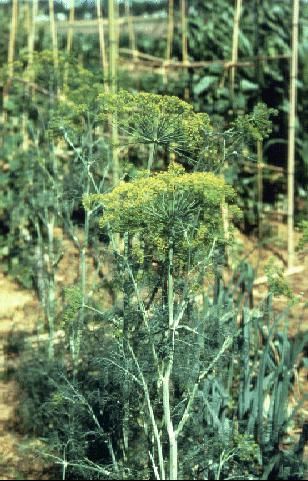Dill, a member of the parsley family, is a strong-smelling, fennel-like, annual plant reaching a height of about 4 feet. The yellow flowers develop into fruiting umbels. In appearance, its seeds are intermediate between those of parsnip and carrot. The seeds as we can see them are not true seeds. They are the halves of very small, dry fruits called schizocarps; these fruits split apart at maturity, with each half containing one seed. Dill was introduced to this country from Asia and appears in the northeastern United States as a roadside weed in July and August. It is cultivated in Germany, India, Romania, England, and to some extent in northern sections of this country. Small acreages of dill have been grown successfully as a commercial crop on the muck soils near Zellwood and Oviedo, as well as on sandy soils in Florida. Dill often is grown in vegetable gardens around the state.

Credit: James M. Stephens
Culture
Dill grows well on an organic soil such as muck and on any other soil suitable for growing vegetables. Normally, the same cultural practices used for a vegetable garden should be used for dill.
The variety 'Long Island Mammoth' is suggested for Florida. Suggested for trial are 'Bouquet' and 'Ting.' Seed should be planted ¼–½ inch deep in rows at the rate of 6 to the foot and thinned to 1 plant every 12 inches. One ounce of seed should plant 50 feet of row. With considerable care, the seedlings may be transplanted if desired. September through December is the best planting time, but dill gives good results when planted in February and March. 'Long Island Mammoth' matures in about 65 days.
Use
Dill is commonly used for flavoring pickles. For this purpose the fruiting tops with several inches of the stem are cut when the fruit is fully developed, but not yet brown. The cut pieces are bunched and cured in the shade. Spread the dry heads on a cloth to cure. Remove seeds by shaking.
Dried or freshly chopped dill leaves are used for broiled or fried meats and fish, in sandwiches and fish sauces. In making dill pickles, generous layers of the dill are placed in the jars or kegs with the pickles to add to their distinctive and popular flavor. The fruiting tops may be used either fresh or dried.